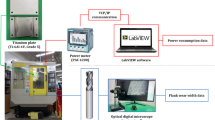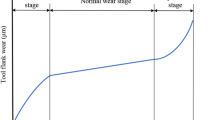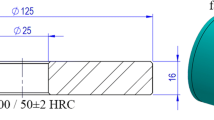Abstract
The ideal scenario for the implementation of a machining process is to be able to predict tool performance without the need to conduct practical experiments. However, in an industrial environment, each set of machining conditions is unique, since the machine-tool conditions, machined material, cutting tool, and fixture system can vary. This can lead to differences between the predicted values and practical results. In this context, the aim of this research was to show and discuss a tool performance test methodology and a tool-life prediction model using the three-dimensional (volumetric) wear parameter WRM (volume of material removed from the tool) applied to hard turning with PCBN tools. The wear parameter WRM is measured at the beginning of the tool life (up to 25%) by focus variation microscopy (FVM). The tool wear rate (WRRM) is then calculated based on the ordinary least squares (OLS) method, and the tool life is estimated (TWRM) adopting the volume of material removed from the tool (WRMmax) as the criteria for the end of tool life. The tool-life model developed was capable of predicting the tool life with errors below 4% at the higher values of cutting speed adopted (vc = 150–187.5 m/min), that is, the cutting speeds applied industrially. The methodology adopted and the model developed represent a significant time reduction in the experimental machining tests, streamlining the research and development of the cutting tool grades, as well as the machining process optimization.










Similar content being viewed by others
References
Arrazola PJ, Özel T, Umbrello D, Davies M, Jawahir IS (2013) Recent advances in modelling of metal machining processes. CIRP Ann - Manuf Technol 62:695–718. https://doi.org/10.1016/j.cirp.2013.05.006
Melkote SN, Grzesik W, Outeiro J, Rech J, Schulze V, Attia H, Arrazola PJ, M’Saoubi R, Saldana C (2017) Advances in material and friction data for modelling of metal machining. CIRP Ann - Manuf Technol 66:731–754. https://doi.org/10.1016/j.cirp.2017.05.002
Malakizadi A, Hosseinkhani K, Mariano E, Ng E, Del Prete A, Nyborg L (2017) Influence of friction models on FE simulation results of orthogonal cutting process. Int J Adv Manuf Technol 88:3217–3232. https://doi.org/10.1007/s00170-016-9023-4
Johansson D, Hägglund S, Bushlya V, Ståhl JE (2017) Assessment of commonly used tool life models in metal cutting. Procedia Manuf 11:602–609. https://doi.org/10.1016/j.promfg.2017.07.154
Usui E, Hirota A, Masuko M (1978) Analytical prediction of three dimensional cutting process—part 1: basic cutting model and energy approach. J Eng Ind 100:222. https://doi.org/10.1115/1.3439413
Usui E, Shirakashi T, Kitagawa T (1984) Analytical prediction of cutting tool wear. Wear. 100:129–151. https://doi.org/10.1016/0043-1648(84)90010-3
Binder M, Klocke F, Lung D (2015) Tool wear simulation of complex shaped coated cutting tools. Wear. 330–331:600–607. https://doi.org/10.1016/j.wear.2015.01.015
Malakizadi A, Gruber H, Sadik I, Nyborg L (2016) An FEM-based approach for tool wear estimation in machining. Wear. 368–369:10–24. https://doi.org/10.1016/j.wear.2016.08.007
Pálmai Z (2013) Proposal for a new theoretical model of the cutting tool’s flank wear. Wear. 303:437–445. https://doi.org/10.1016/j.wear.2013.03.025
Attanasio A, Ceretti E, Fiorentino A, Cappellini C, Giardini C (2010) Investigation and FEM-based simulation of tool wear in turning operations with uncoated carbide tools. Wear. 269:344–350. https://doi.org/10.1016/j.wear.2010.04.013
Takeyama H, Murata R (1963) Basic investigation of tool Wear. J Eng Ind 85:33. https://doi.org/10.1115/1.3667575
F. Ramírez P, Soldani X, Loya J, Miguélez H (2017) A new approach for time-space wear modeling applied to machining tool wear. Wear 390–391:125–134. https://doi.org/10.1016/j.wear.2017.07.015
Matsumoto Y, Barash MM, Liu CR (1987) Cutting mechanism during machining of hardened steel. Mater Sci Technol 3:299–305. https://doi.org/10.1179/026708387790122756
König W, Berktold A, Koch K-F (1993) Turning versus grinding – a comparison of surface integrity aspects and attainable accuracies. CIRP Ann - Manuf Technol 42:39–43. https://doi.org/10.1016/S0007-8506(07)62387-7
Koch K-F (1996) Technologie des Hochpräzisions-Hartdrehens, RWTH-Aachen
Poulachon G, Moisan A, Jawahir IS (2001) Tool-wear mechanisms in hard turning with polycrystalline cubic boron nitride tools. Wear 250:576–586. https://doi.org/10.1016/S0043-1648(01)00609-3
Huang Y, Liang SY (2004) Modeling of CBN tool flank wear progression in finish hard turning. J Manuf Sci Eng 126:98. https://doi.org/10.1115/1.1644543
Boing D, Schroeter RB, de Oliveira AJ (2018) Three-dimensional wear parameters and wear mechanisms in turning hardened steels with PCBN tools. Wear. 398–399:69–78. https://doi.org/10.1016/j.wear.2017.11.017
ISO 3685:1993 (1993) Tool life testing with single-point turning tools. International Organization for Standardization ISO 3685
Boing D (2016) Transição da aplicação do metal-duro revestido e do PCBN no torneamento de aços endurecidos em função da dureza e do teor de carbonetos, Universidade Federal de Santa Catarina – UFSC. http://www.bu.ufsc.br/teses/PEMC1752-T.pdf
Brecher C, Esser M, Witt S (2009) Interaction of manufacturing process and machine tool. CIRP Ann 58:588–607. https://doi.org/10.1016/j.cirp.2009.09.005
Klocke F (2010) Manufacturing processes 1: cutting. https://doi.org/10.1007/978-3-642-11979-8
Danzl R, Helmli F, Scherer S (2009) Focus variation - a new technology for high resolution optical 3D surface metrology. In: 10th Int. Conf. Slov. Soc. Non-Destructive Test, pp 1–10. https://doi.org/10.5545/sv-jme.2010.175
Boing D, de Oliveira AJ, Schroeter RB (2018) Limiting conditions for application of PVD (TiAlN) and CVD (TiCN/Al2O3/TiN) coated cemented carbide grades in the turning of hardened steels. Wear. 416–417:54–61. https://doi.org/10.1016/j.wear.2018.10.007
Castro FL, Boing D, Schroeter RB (2018) Tool performance assessment based on three-dimensional tool wear rate. Procedia CIRP 77:638–641. https://doi.org/10.1016/j.procir.2018.08.188
Acknowledgements
The authors would like to thank Sandvik Coromant® for supplying the cutting tools, Alicona® for providing resources and discussions on the measurement methods, and Villares Metals® for supplying the steel alloys.
Funding
The authors would like to thank CNPq (National Council for Scientific and Technological Development) for their financial support.
Author information
Authors and Affiliations
Corresponding author
Additional information
Publisher’s note
Springer Nature remains neutral with regard to jurisdictional claims in published maps and institutional affiliations.
Rights and permissions
About this article
Cite this article
Boing, D., Castro, F.L. & Schroeter, R.B. Prediction of PCBN tool life in hard turning process based on the three-dimensional tool wear parameter. Int J Adv Manuf Technol 106, 779–790 (2020). https://doi.org/10.1007/s00170-019-04509-0
Received:
Accepted:
Published:
Issue Date:
DOI: https://doi.org/10.1007/s00170-019-04509-0




